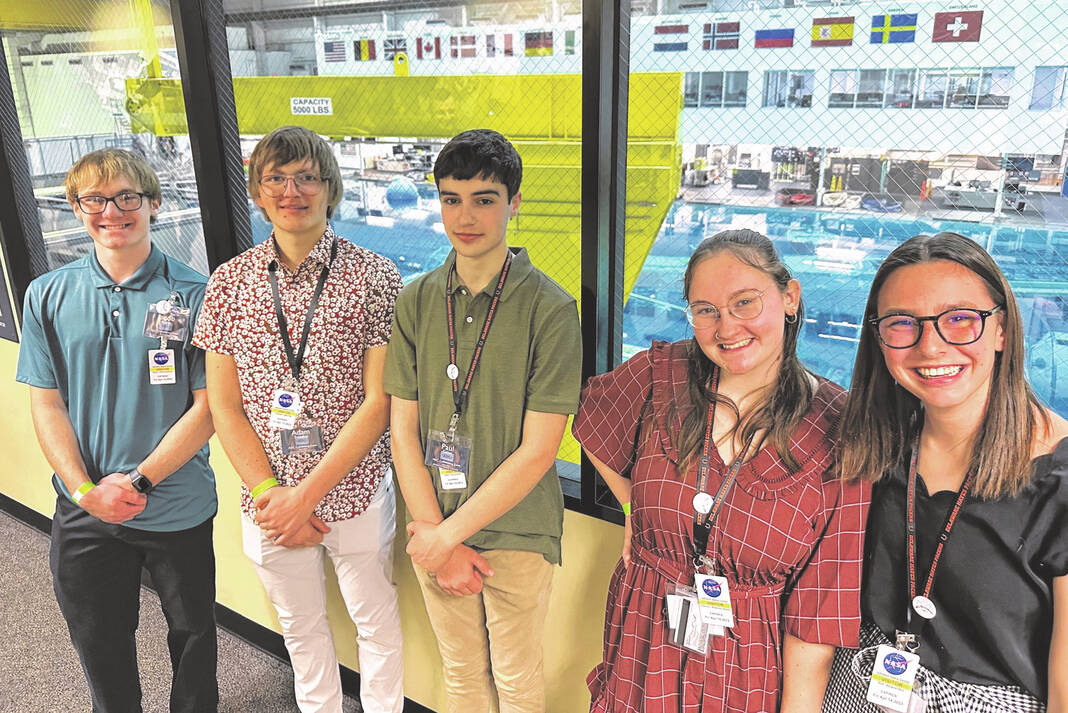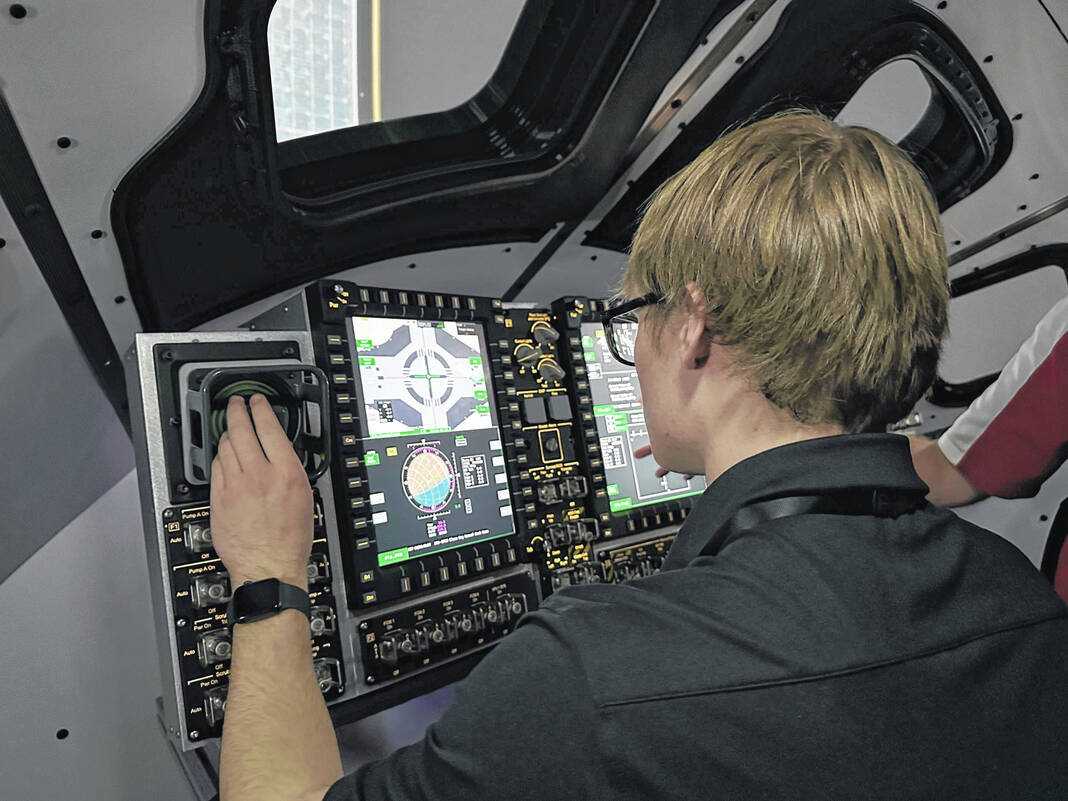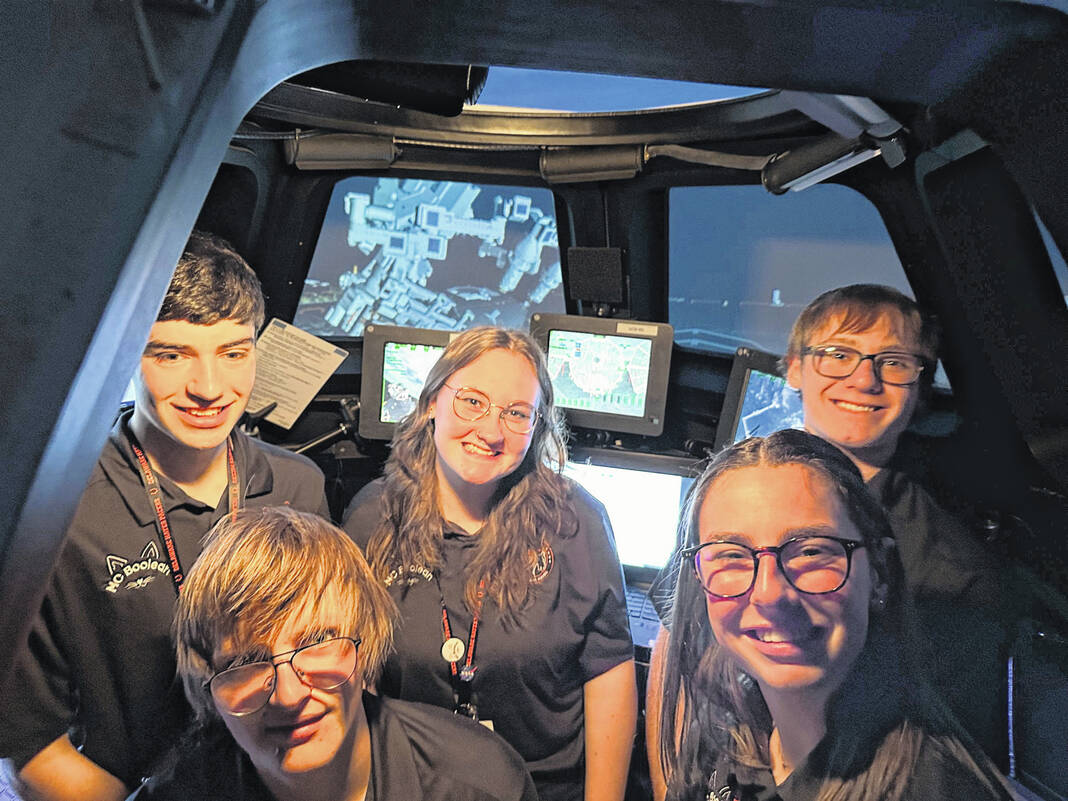

Hayes student Jacob Payne uses a simulator module used by NASA to train astronauts.
Joanne Meyer | Hayes High School

The team from Hayes High School stands in one of the simulator modules during their trip to Johnson Space Center. Pictured, left to right, are (back row): Paul Gabel, Rosemary Cranston and Jacob Payne; front row: Adam Fronduti and Meg Wolf.
Joanne Meyer | Hayes High School
Last weekend, five Hayes High School students traveled to Houston, Texas, and presented an app they developed to NASA, concluding a monthslong competition.
The team of students consists of seniors Adam Fronduti, Paul Gabel, Jacob Payne and Meg Wolf, as well as junior Rosemary Cranston. The team submitted its app to NASA’s app development contest last year and were invited to Houston in February. The team departed the state on April 12 and returned on April 14 after visiting the John Space Center and many of its facilities, along with presenting its app to NASA researchers.
The students said one of the highlights of the trip was a visit to the Neutral Buoyancy Laboratory, where astronauts can experience conditions similar to space flight so they can train in extravehicular activity (EVA) tasks. The students said the facility has a full-sized mock-up of the International Space Station submerged in a 6.2-million-gallon tank of water.
“We got to hear about the inner workings of how training there works,” Wolf said. “(I thought), ‘How can this just be a building in the middle of Texas?’ It was stuff straight out of a sci-fi movie.”
As inspiring as the experience was, Wolf had one problem with the tour.
“They wouldn’t let us in the pool though,” she laughed.
The team visited the space center’s Avionics Lab where they tested and played with many of the virtual reality simulators that NASA uses to train astronauts.
The team explained that all the simulators were built in Unity, the same engine that they designed their winning app in.
“So, we all wanted to be like, ‘How can we make our app do this?’” Wolf said. “It was really cool getting to talk to the guys that programmed it in person and ask them questions.
Gabel agreed, adding the experience was interesting.
“It was really cool to see what NASA is using is what we used,” Gabel said. “(Our app was) at a much more primitive level, but it was neat to see what we were doing applied to the real world.”
The students said they were hypercompetitive during the simulators and were trying to beat each other as well as compete with actual astronauts.
Cranston said she received a nearly perfect score on one of the simulators.
“I basically could be an astronaut,” Cranston said jokingly.
The rest of the team was quick to remind her that she had flipped over the moon rover during that challenge. Fronduti admitted he drove his rover into a crater on purpose.
“Rosie was the best at basically any (simulator) except when she flipped the rover,” Wolf added. “I went first, and we all were very competitive. They are very precise. I just went for it as fast as I could. We know it’s millions and millions of dollars, but it felt like a video game. That’s how these people learn to do their job. It was just so fun.”
The students also saw the disassembled rover that will head to the Moon, which was the subject of the navigation app they developed.
“You don’t realize it when you’re there but when you leave, you’re like, ‘Wow, I literally just walked past something that is going to be on the Moon,’” Payne said.
The students said they presented their app during the trip and got to speak to the other teams in the competition.
“Other teams did a lot of the same things but did a lot of things differently,” Gabel said.
“We were the only team with five kids,” Wolf added. “It was cool to learn how everyone got to where we were.”
Fronduti said he enjoyed giving the presentation and showing off the app the team developed. Joanne Meyer, the team’s advisor, said she’s proud of how the team handle their presentation.
“Your personalities came through,” Meyer said to the team Wednesday. “You were having conversations. I heard them whispering about you guys.”
The team returned on April 14 and returned to classes on Monday.
“It was kind of bittersweet because we did it, we went to NASA. It was super fun, but now we’re done,” Payne said Thursday. “I was literally thinking, ‘This was the most important thing I’ve ever done.’”
Payne said he learned from one of the NASA researches to challenge himself “so the hard things become easier.”
Wolf agreed about the bittersweet feeling, adding she thought, “Now what? (Back to) high school?” after the presentation.
“It was definitely kind of hard to accept that this was done, but we’re already thinking about what is next,” Wolf said. “It was a great time to be five kids who got to explore and look at things we’re all interested in. The hard work paid off so much. The presentation we did was the best 30 minutes of my life. … I stood in mission control, gave a presentation, and then they dropped us off at the airport. It was a fever dream and then we were home.”
Gabel said he’s already looking forward to the next app development challenge, even after he graduates.
“We can’t stop with this, we have to stop with something else,” Gabel said. “I realized that difficult projects can be a lot of fun.”
Cranston said she’s grateful for the whole experience and one day hopes to work in bio-medicine, possibly with NASA.
“The trip and the entire project itself has given me more opportunities than I thought it would,” Cranston said. “I probably wouldn’t have flown on an airplane. I don’t travel much in general, so it was just really fun. … I never thought I’d see NASA. I never thought space was something I’d be looking into. It was such a good age to do something like that.”
This weekend the team will travel to Carnegie Mellon University and the National Robotics Engineering Center in Pittsburgh, Pennsylvania, from April 23-24 after being invited to speak at the center where moon rover the team’s app was designed around was created.
Glenn Battishill can be reached at 740-413-0903 or on Twitter @BattishillDG.

